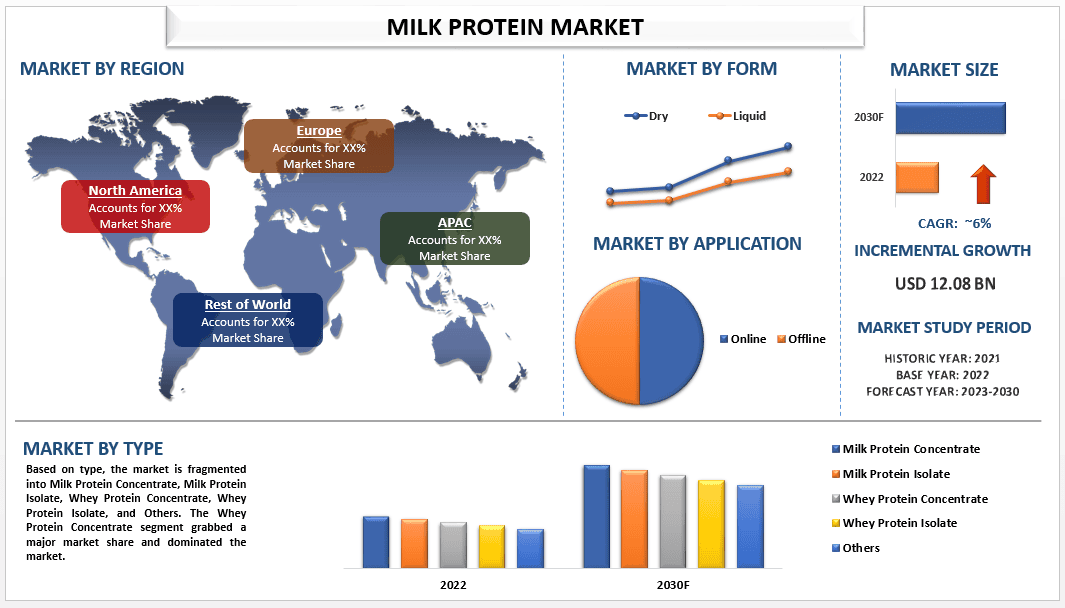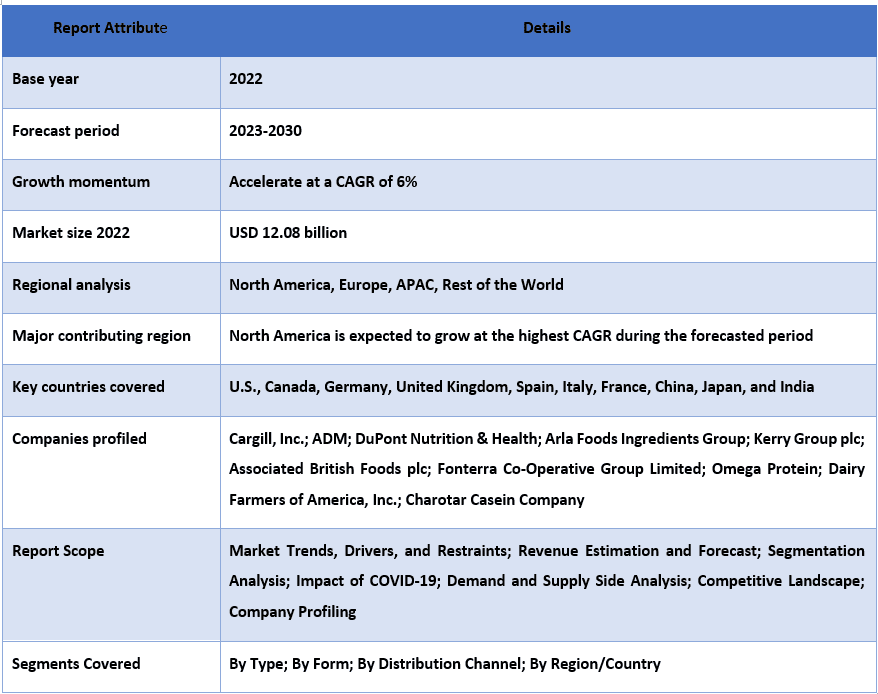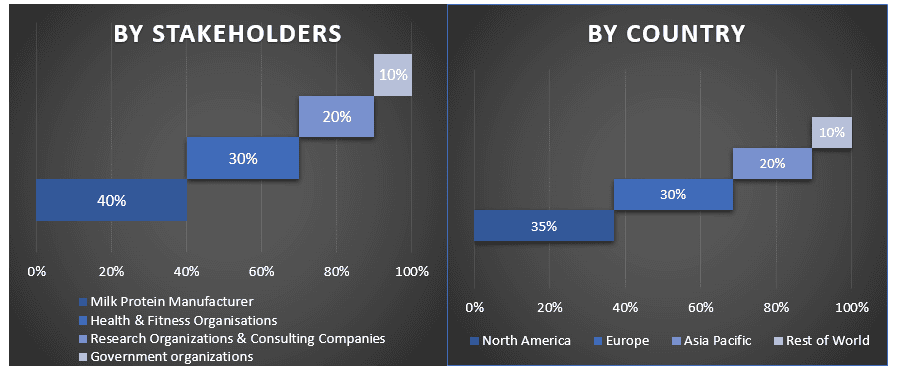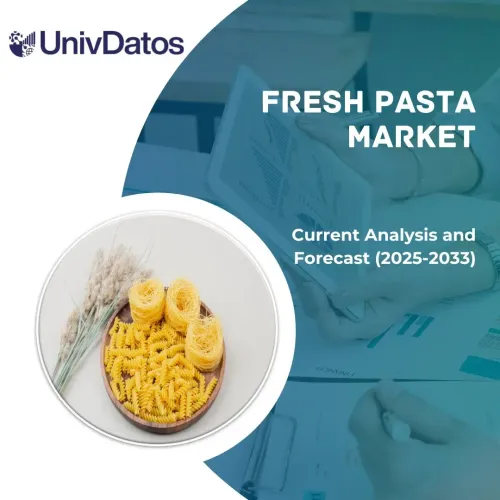- Home
- About Us
- Industry
- Services
- Reading
- Contact Us
Global Milk Protein Market: Current Analysis and Forecast (2023-2030)
Emphasis on Type (Milk Protein Concentrate, Milk Protein Isolate, Whey Protein Concentrate, Whey Protein Isolate, and Others); Form (Dry and Liquid); Distribution Channel (Online and Offline); and Region/Country.

The global milk protein market is expected to grow at a strong CAGR of around 6% during the forecast period. Milk Protein is one of the longest-used protein supplements and has numerous benefits. It is widely used due to its high quality and rate of absorption. More specifically, the prolonged-release properties of Milk Protein make it ideal for any period where the body needs a sustained release of protein. Also, milk proteins contain all 9 essential amino acids required by humans. Milk proteins are synthesized in the mammary gland, but 60% of the amino acids used to build the proteins are obtained from the cow’s diet. In cow’s milk, approximately 82% of milk protein is casein and the remaining 18% is serum or whey protein. Factors such as surging cases of muscle tissue breakdown due to improper nutrition, a rising number of gym and fitness enthusiasts, an emerging aging population, etc. Many major companies in the market are launching new products to increase the variants for protein. For instance, in December 2022, Perfect Day whipped up interest in animal-free milk proteins by developing whey protein.
Cargill, Inc.; ADM; DuPont Nutrition & Health; Arla Foods Ingredients Group; Kerry Group plc; Associated British Foods plc; Fonterra Co-Operative Group Limited; Omega Protein; Dairy Farmers of America, Inc.; Charotar Casein Company etc. are some of the prominent players operating in the Milk Protein market. Several M&As along with partnerships have been undertaken by these players to facilitate customers with hi-tech and innovative products.
Insights Presented in the Report
“Amongst Form, dry form is expected to have a significant share during the forecasted period”
Based on the form, the market is segmented into dry and liquid. The dry form is expected to have a significant share during the forecasted period. This is mainly owing to the properties of dry milk protein such as longer shelf life and ease of carry etc. Due to longer shelf life and ease-to-carry properties, the dry form of milk protein is further used as an ingredient in various food and beverage products, including sports nutrition products, infant formulas, bakery products, dairy products, and confectionery items which in turn capitalize the respect segment to hold the major share in the market.
Milk Protein Market Report Coverage

“Amongst distribution channel type, online distribution channel is expected to rise during the forecast period”
Based on the distribution channel, the market is bifurcated into online and offline. The online distribution channel is expected to rise during the forecast period. This is mainly owing to factors such as the rapid penetration of e-commerce and online grocery shopping. It is more convenient now to easily purchase milk protein from the comfort of their own homes and have it delivered to their doorstep. Additionally, online retail stores have a wide selection of milk protein, which in turn is increasing the demand for the product.
“North America is expected to have the largest market share during the forecast period”
North America milk protein market is expected to have the largest market share during the forecast period. This is mainly due to the growing demand for protein-rich foods and beverages, particularly among health-conscious consumers. Milk protein is a popular choice for this group because it is a high-quality protein source that is also rich in other nutrients like calcium, vitamin D, and omega-3 fatty acids. Additionally, the increasing popularity of plant-based and vegan diets has led to an increase in demand for milk protein as a substitute for animal-derived protein sources. Additionally, Dairy farmers are increasingly focusing on producing milk protein as a commodity crop, which has led to a decrease in the price of milk protein and made it more accessible to a wider range of consumers. This has in turn led to an increase in the demand for milk protein from both domestic and international markets.
Reasons to buy this report:
- The study includes market sizing and forecasting analysis validated by authenticated key industry experts
- The report presents a quick review of overall industry performance at one glance
- The report covers an in-depth analysis of prominent industry peers with a primary focus on key business financials, product portfolio, expansion strategies, and recent developments
- Detailed examination of drivers, restraints, key trends, and opportunities prevailing in the industry
- The study comprehensively covers the market across different segments
- Deep dive regional level analysis of the industry
Customization Options:
The milk protein market can further be customized as per the requirement or any other market segment. Besides this, UMI understands that you may have your own business needs, hence feel free to connect with us to get a report that completely suits your requirements.
Table of Content
Research Methodology for the Global Milk Protein Market Analysis (2023-2030)
Analyzing the historical market, estimation of the current market, and forecasting the future market of the Milk Protein Market were the three major steps undertaken to create and analyze the demand for Milk Protein across major regions. Exhaustive secondary research was conducted to collect the historical market numbers and estimate the current market size. Secondly, to validate these insights, numerous findings and assumptions were taken into consideration. Moreover, exhaustive primary interviews were also conducted, with industry experts across the value chain of the Milk Protein market. Post assumption and validation of market numbers through primary interviews, we employed a top-down/ bottom-up approach to forecast the complete market size. Thereafter, market breakdown and data triangulation methods were adopted to estimate and analyze the market size of segments and sub-segments the industry pertains to. Detailed methodology is explained below:
Analysis of Historical Market Size
Step 1: In-Depth Study of Secondary Sources:
Detailed secondary study was conducted to obtain the historical market size of the Milk Protein through company internal sources such as annual reports & financial statements, performance presentations, press releases, etc., and external sources including journals, news & articles, government publications, competitor publications, sector reports, third-party database, and other credible publications.
Step 2: Market Segmentation:
After obtaining the historical market size of the milk protein market, we conducted a detailed secondary analysis to gather historical market insights and share for type, form, and distribution channel for major regions. Major segments included in the report are application and livestock. Further region and country-level analyses were conducted to evaluate the overall adoption of milk protein across the globe.
Step 3: Factor Analysis:
After acquiring the historical market size of different segments and sub-segments, we conducted a detailed factor analysis to estimate the current market size of milk protein. Further, we conducted factor analysis using dependent and independent variables such as surging cases of muscle tissue breakdown due to improper nutrition, a rising number of gym and fitness enthusiasts, an emerging aging population, etc, A thorough analysis was conducted for demand and supply-side scenarios considering top partnerships, merger and acquisition, business expansion, and product launches in the milk protein industry across the globe.
Current Market Size Estimate & Forecast
Current Market Sizing: Based on actionable insights from the above 3 steps, we arrived at the current market size, key players in the Milk Protein market, and market shares of the segments. All the required percentage shares split, and market breakdowns were determined using the above-mentioned secondary approach and were verified through primary interviews.
Estimation & Forecasting: For market estimation and forecast, weightage was assigned to different factors including drivers & trends, restraints, and opportunities available for the stakeholders. After analyzing these factors, relevant forecasting techniques i.e. bottom-up/ top-down approach were applied to arrive at the market forecast for 2030 for different segments and subsegments across the major markets globally. The research methodology adopted to estimate the market size encompasses:
- The industry’s market size, in terms of value (US$) and the adoption rate of Milk Protein across the major markets domestically
- All percentage shares, splits, and breakdowns of market segments and sub-segments
- Key players in the Milk Protein market in terms of services offered. Also, the growth strategies adopted by these players to compete in the fast-growing market
Market Size and Share Validation
Primary Research: In-depth interviews were conducted with the Key Opinion Leaders (KOLs) including Top Level Executives (CXO/VPs, Sales Head, Marketing Head, Operational Head, and Regional Head, Country Head, etc.) across major regions. Primary research findings were then summarized, and statistical analysis was performed to prove the stated hypothesis. Inputs from primary research were consolidated with secondary findings, hence turning information into actionable insights.
Split of Primary Participants in Different Regions

Market Engineering
Data triangulation technique was employed to complete the overall market estimation and to arrive at precise statistical numbers of each segment and sub-segment of the milk protein market. Data was split into several segments & sub-segments post studying various parameters and trends in the areas of type, form, and distribution channel of the milk protein market.
Main Objective of the Milk Protein Market Study
The current & future market trends of milk protein were pinpointed in the study. Investors can gain strategic insights to base their discretion on investments from the qualitative and quantitative analysis performed in the study. Current and future market trends determined the overall attractiveness of the market at a regional level, providing a platform for the industrial participant to exploit the untapped market to benefit as a first-mover advantage. Other quantitative goals of the studies include:
- Analyze the current and forecast market size of Milk Protein in terms of value (US$). Also, analyze the current and forecast market size of different segments and sub-segments
- Segments in the study include areas of type, form, and distribution channel
- Define and analysis of the regulatory framework for the milk protein industry
- Analyze the value chain involved with the presence of various intermediaries, along with analyzing customer and competitor behaviors of the industry
- Analyze the current and forecast market size of the milk protein market for the major countries
- The major region studied in the report includes North America, Europe, Asia- Pacific and Rest of the World.
- Company profiles of the milk protein market and the growth strategies adopted by the market players to sustain in the fast-growing market
- Deep dive regional level analysis of the industry
Related Reports
Customers who bought this item also bought










